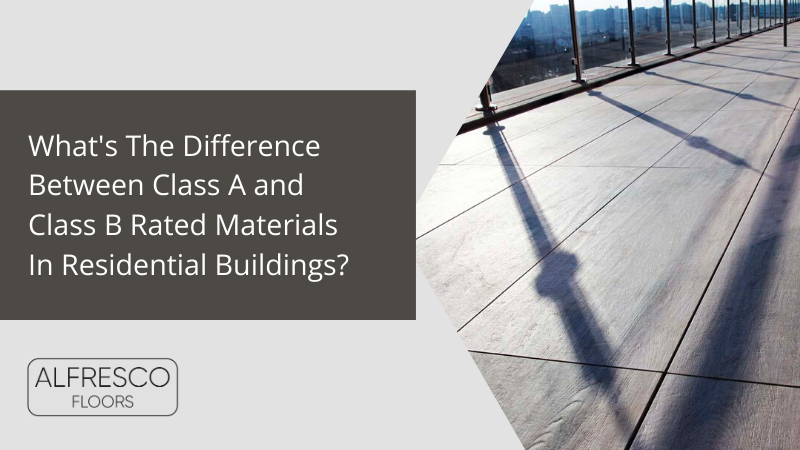
26 Jun What’s The Difference Between Class A and Class B Rated Materials In Residential Buildings?

The current fire regulations for external flooring in the United Kingdom do not allow combustible materials to be used on specified attachments in residential buildings that are above 18 meters in height.
These regulations are in place to prevent additional tragedies should a fire break out. By utilising the best non-combustible materials for balconies, terraces, walkways, roof gardens, and other external flooring, you will remain in compliance with current UK fire regulations and ensure your building is as safe as possible for all future tenants. This blog post will explain the differences between class A rated materials and class B materials.
Class A Rated Materials Meet Current Fire Regulations
Class A rated materials are the only materials that can be specified on external applications and specified attachments on buildings higher than 18 meters. Only materials that are rated A1 or A2 are considered non-combustible materials according to the European Classification (Euroclass) System. Some examples of these materials include:
Euroclass A1 Examples
- A-PED ™ Pedestals
- REIF DuraLink ®
- Porcelain Tiles
- Concrete Pavers
- Natural Stone Pavers
- Metal Components (such as steel)
Euroclass A2 Examples
- Powder Coated Aluminium Decking
- Materials Containing Small Amounts of Organic Matter
The difference between these two types of class A rated materials is their combustibility. A1 materials are completely non-combustible whereas A2 materials have incredibly limited combustibility. Both types are considered non-combustible and are permitted on external applications on buildings of any height.

Class B Rated Materials Have Limited Applications
Class B rated materials should never be used on buildings that are over 18 meters in height as you risk violating current fire regulations. While these materials are highly resistant to flame spread in the event of a fire, they are still considered combustible per the United Kingdom’s fire regulations for external flooring. A few examples of B rated materials include:
- Buzon B-rated pedestal range
- Self-Extinguishing Pedestals
- GRAD Composite Decking
If these materials are used on buildings that are over 18 meters, a fire safety inspector will highlight this during your inspection. At that time, he or she will provide you with remedy actions you can complete to gain compliance.
If class B rated materials (or lower) have been used extensively throughout your building, the inspector will bring in the building owner and discuss professional options. In order to prevent remedies, class A materials should be used from the beginning.
The Difference Summarised
The only non-combustible materials for balconies, roof gardens, and other specified attachments on buildings over 18 meters are class A rated materials. Buildings under this height can use A1, A2, or class B materials. Both types of materials will help prevent the flame spread, but only class A materials are considered non-combustible.
In order to protect future residents in the residential buildings you are constructing and have peace of mind you are meeting the UK’s fire regulations, it is advised to utilise A-rated solutions from Alfresco Floors. Please do not hesitate to get in touch with one of our expert associates today.




Pingback:What is Class A Decking? - Alfresco Floors
Posted at 12:43h, 07 December[…] to Look Out for When Specifying Fire-Rated Pedestals What’s The Difference Between Class A and Class B Rated Materials In Residential Buildings? The Use of Non-Combustible Materials: What the Law […]
Pingback:Why is Class A Decking Important? - Alfresco Floors
Posted at 12:46h, 07 December[…] What’s The Difference Between Class A and Class B Rated Materials In Residential Buildings? The Use of Non-Combustible Materials: What the Law States […]
Pingback:What Surface Materials Deliver Class A Decking? - Alfresco Floors
Posted at 13:41h, 11 December[…] What’s The Difference Between Class A and Class B Rated Materials In Residential Buildings? […]